Parker House Rolls are soft, fluffy, buttery and incredibly delicious! They’re the perfect roll to complement any dinner or holiday gathering. Plus, they make great options for sandwiches after cooking up those Thanksgiving turkeys or Christmas hams! Light and fluffy, these rolls are sure to be the best thing on your plate.
Wondering what could possibly make these rolls better? Try adding some Brown Sugar Cinnamon Butter, Honey Butter, or get sweet and seasonal with this homemade Pumpkin Butter!
This post is sponsored by Challenge Dairy.
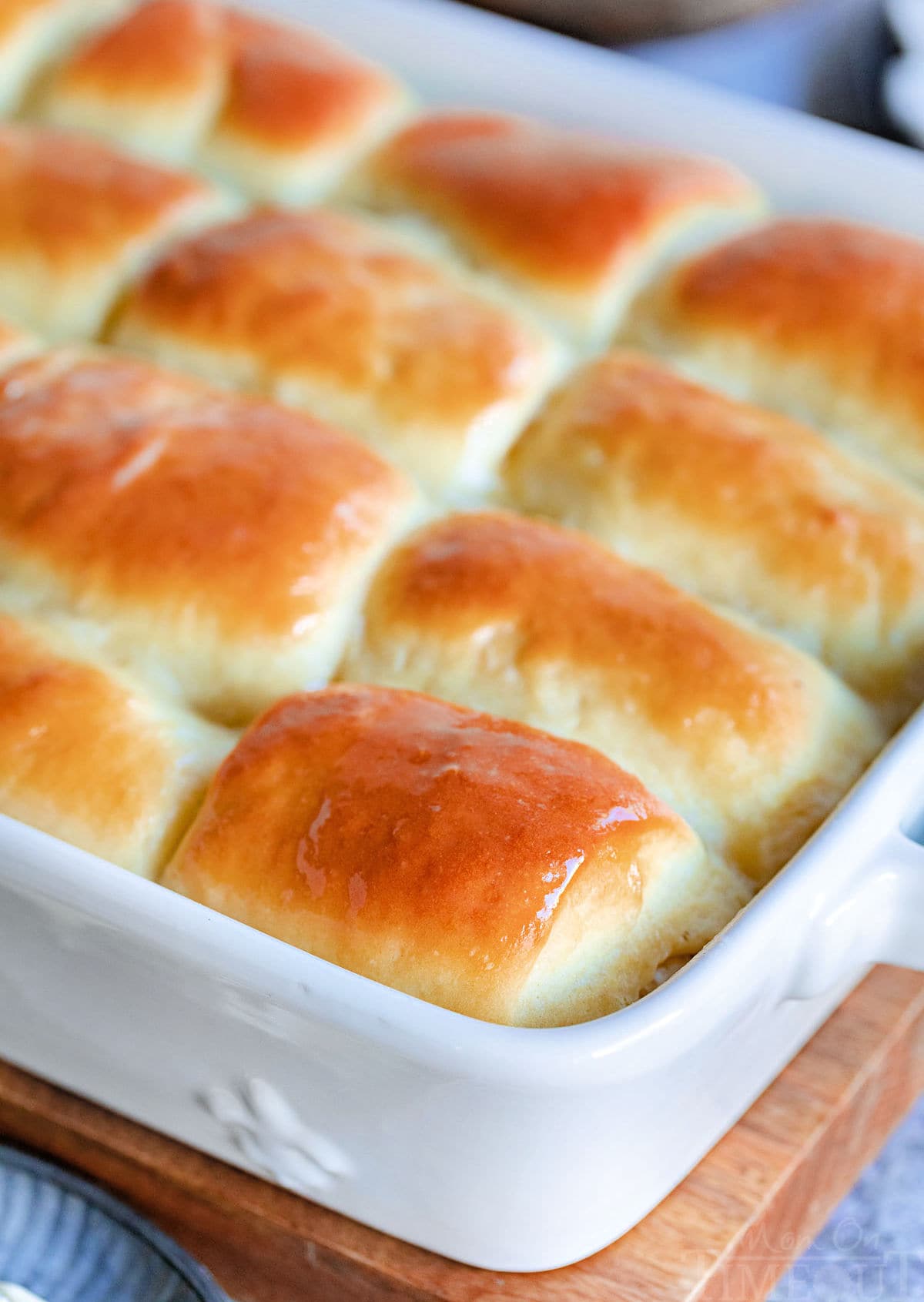
Parker House Rolls
Bread lovers rejoice! I’ve got the ultimate dinner roll recipe for you. Soft, light, fluffy, buttery, pull apart Parker House Rolls are the elite option when it comes to bread sides. Sometimes called “purse rolls” because of their fold in the middle, they tend to look like pocketbooks. My boys call them already-been-buttered rolls but that doesn’t stop any of us from adding a little more…
Typically when it comes to the holidays, savory side dishes reign supreme… but these little rolls are about to steal the show. While you could buy the frozen versions at your local supermarket, homemade is really where it’s at. Eating one of these fresh from the oven brings a joy that can’t be matched. Pass the butter, please!
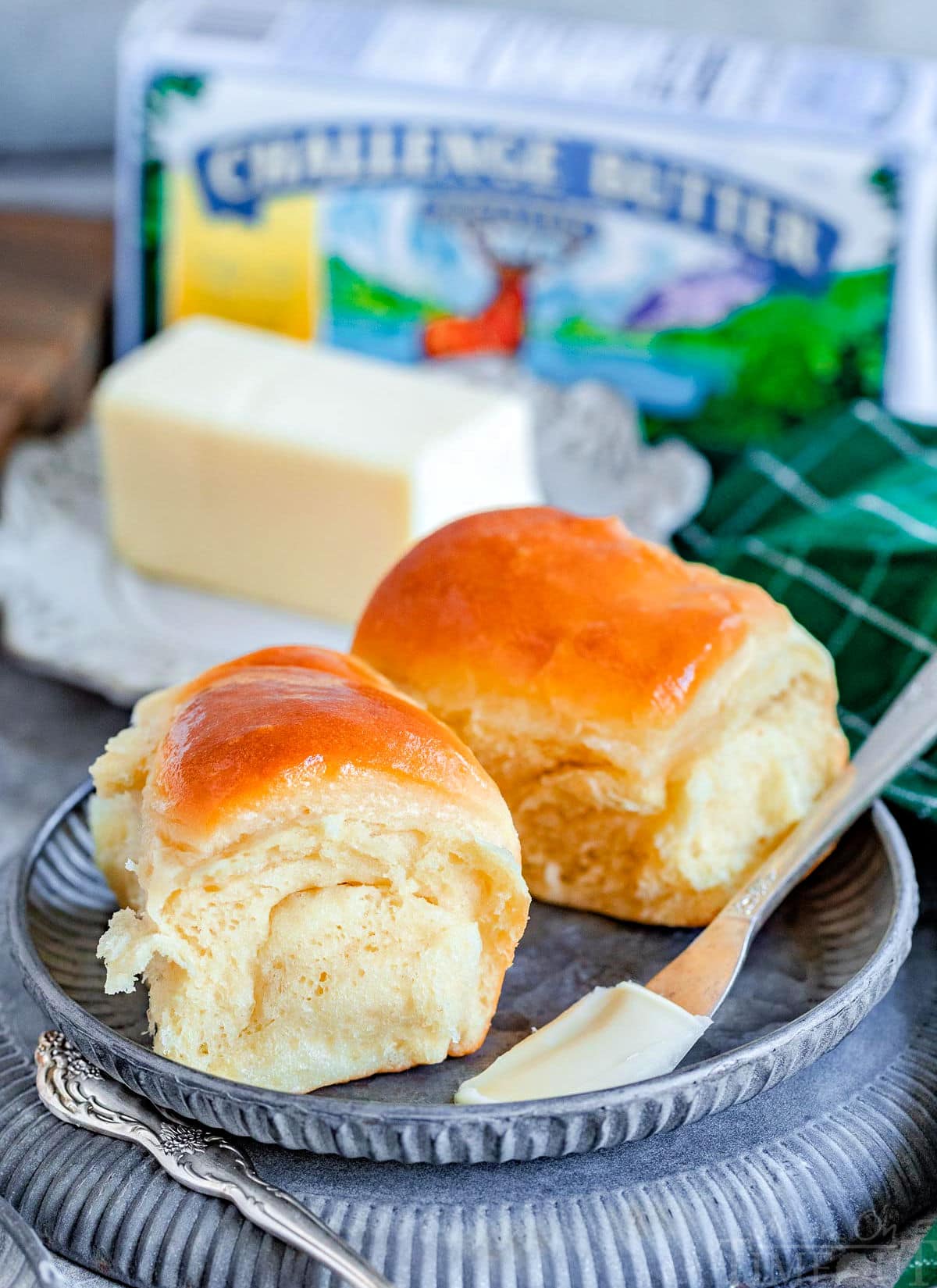
Why I Love This Parker House Rolls Recipe
Why do I love these delicious dinner rolls?
- The process is worth the payoff. Sometimes you come across slightly more complicated recipes and the end result just isn’t worth the time and effort you spent making the dish. Well, not with these! These rolls are 100% the effort every time!
- This recipe is made from pantry staples. No specific flour or other hard to find ingredients. You can bake a batch with what you already have in your kitchen.
The Proper Way To Eat A Parker House Roll
Parker House Rolls are incredible because they are pre-buttered and split apart beautifully – ready to fill with your favorites. Whether it’s butter and jelly like I have shown below, or a combination of cranberry sauce, cornbread stuffing and a couple slices of crockpot turkey breast dunked in turkey gravy – you really can’t go wrong.
My boys call them already-been-buttered rolls but that doesn’t stop any of us from adding a little more…
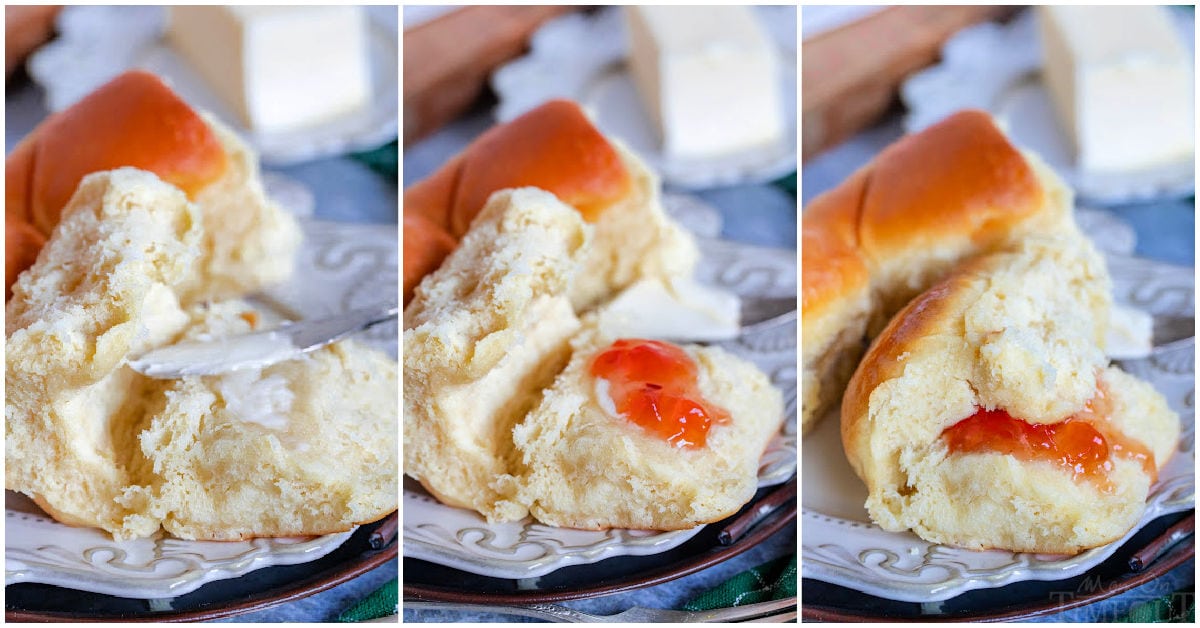
More Tasty Holiday Side Dishes
I used Challenge butter in this Parker House Rolls recipe because it’s the BEST. Challenge is the brand of butter I’ve used and trusted for years and years. Made with 100% real cream, it’s my butter of choice. I’ve been using Challenge products my whole life and trust their products. I know the quality is outstanding and use it for all my baking and cooking!
Try one of the Challenge’s Seasoned Butters to spread on top of these rolls – the Challenge Everything Butter Snack Spread and Challenge Garlic Parmesan with Herbs Butter Snack Spread are delicious!
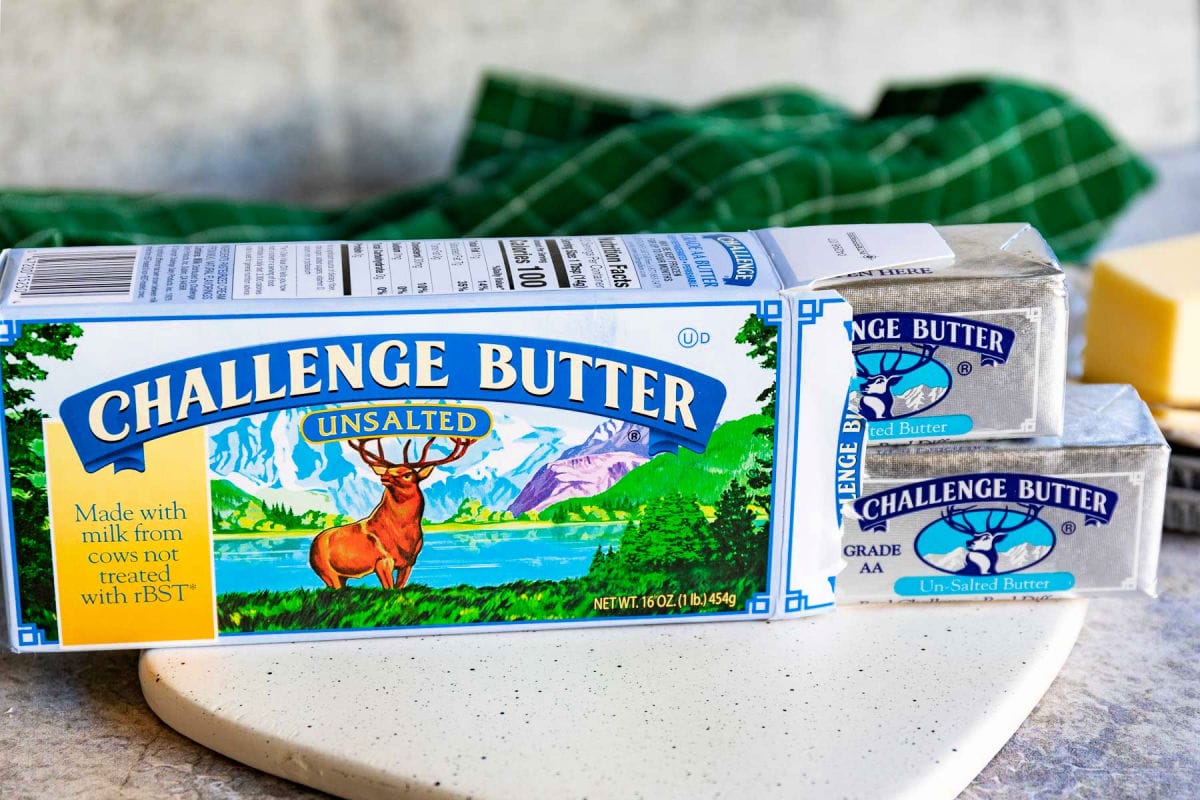
What You’ll Need
Parker House Rolls aren’t famous for nothing. See why they’ve been a staple on the dinner table since 1855 by making your own! As always, you can find the full printable recipe with complete instructions in the recipe card at the end of this post. Let’s take a look at what you’ll need…
- whole milk – Make sure it reaches a temperature of 110°F
- active dry yeast – To get that perfect texture and rise. If you want to use rapid rise yeast (I do about half of the time), just swap it in the recipe and expect the rise times to be reduced a bit. You don’t have to let the yeast sit at all either, just add all of the ingredients in and start mixing.
- unsalted butter – Unsalted and softened (but not melted). This adds that buttery flavor to the rolls that makes them so good. You’ll need butter in three different stages in this recipe: in the dough, brushing on the dough before rolling and rising and then again for brushing on the rolls after baking.
- sugar – White granulated, divided. Helps the yeast to activate and adds a slight sweetness to the rolls.
- sea salt – You’ll want fine not coarse salt. Kosher salt can also be used.
- eggs – One whole egg and one yolk. Both at room temperature. The eggs add richness to the rolls.
- all-purpose flour – I love that this recipe doesn’t require bread flour however, I have made this recipe every way possible and it can absolutely be made with bread flour if you prefer.

How To Make Parker House Rolls
After years of making these rolls the hard, “traditional” way which involved a whole lot of unnecessary work, I’ve simplified the process and believe the results speak for themselves. They are still homemade rolls which, yes, require a bit of effort, but I’ve eliminated a lot of the extra steps. This recipe for Parker House Rolls is worth every single second! Let’s take a look at how to make these rolls:
Make The Dough
- Combine the active dry yeast, warm milk, and 2 tablespoons of the granulated sugar in a large bowl. Whisk and let sit for about 5 minutes, until the mixture becomes foamy.
- Add 2 ½ cups of flour, sea salt, softened butter, egg, and egg yolk to the yeast mixture. Using an electric mixer fit with a paddle attachment, mix on the lowest speed until all ingredients are incorporated. Mix for 2 more minutes at medium speed.
- Switch the attachment to a dough hook. Add ½ cup of flour and mix at the lowest speed. Once the flour is almost fully combined, mix at medium speed. About 2 minutes total.
- Add another ½ cup of flour and repeat the method. At this point a ball of dough should be formed. You can add a tablespoon or two of extra flour at a time if needed but the dough should be soft and sticky. It should still be sticking to the bottom of the bowl but starting to pull away from the edges.
- Transfer the dough to a bowl sprayed with nonstick cooking spray. Cover it with a towel or plastic wrap and leave the dough to rise at room temperature until it has doubled in size. This can take anywhere from 45-90 minutes usually.
- Remove the cover once it has doubled and gently punch the dough down. Divide the dough in half and place on a very lightly floured surface.
Roll Out Rolls
- Roll out the dough into a rectangular shape about the size of a piece of printer paper, we’re looking for 12 inches by 8 inches.
- Brush the dough with about 2 tablespoons of the softened butter. You’ll want a light coating of the entire thing.
- Cut the dough in half lengthwise. Fold each rectangle lengthwise but leave about ½ an inch of the edges showing.
- Cut the folded rectangles of dough in half and then in half again. You should have 8, roughly 3 inch, pieces of dough.
- Grease a 9×13 inch baking dish. Place the rolls with the folded side down, 4 in a row (longer sides matching the longer sides of the dish).
- Repeat the entire process with the second ball of dough. You should end up with 16 rolls total.
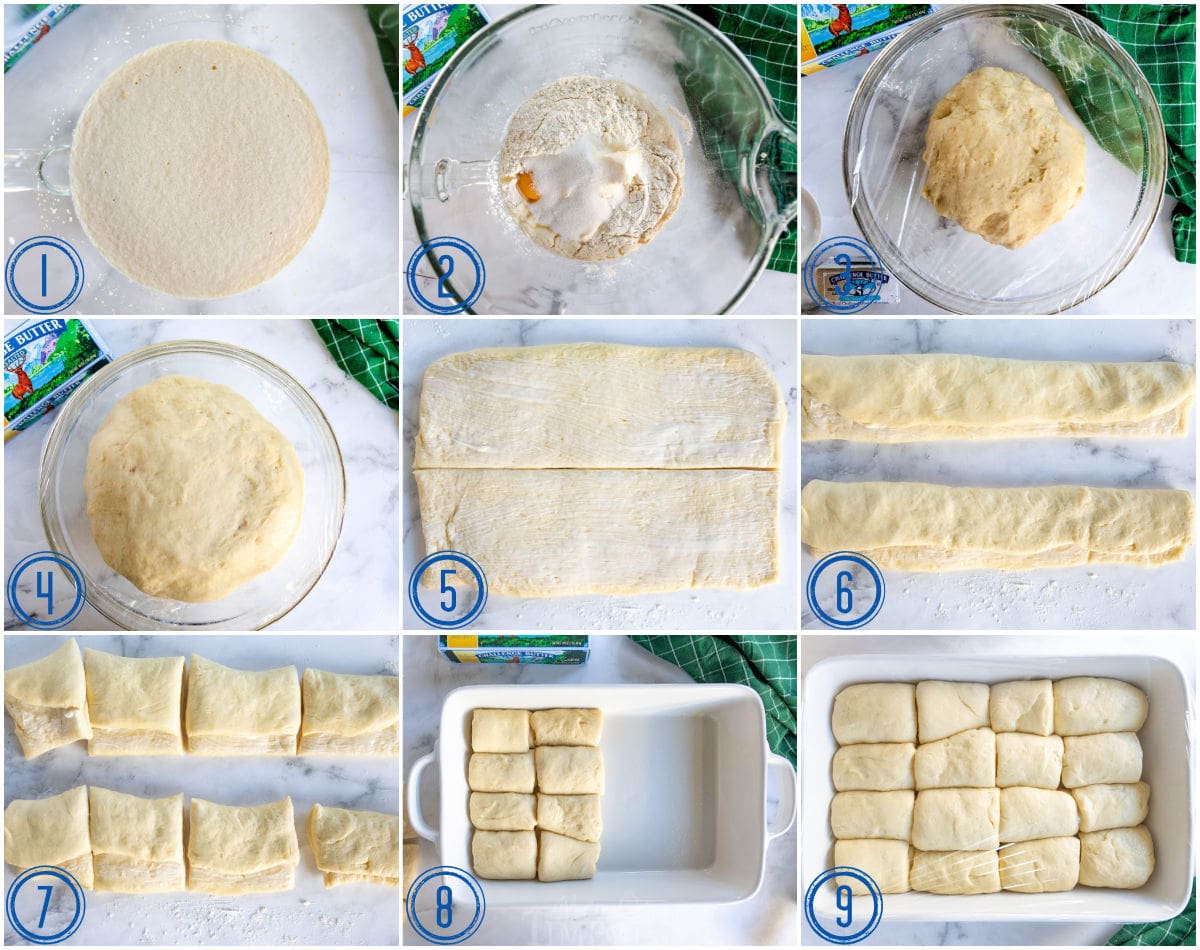
Bake and Butter
- Cover the baking dish again with a towel or plastic wrap and let the rolls rise once more for about an hour until they have puffed up to almost double in size.
- Preheat your oven to 350°F. Bake the rolls for 20-25 minutes. They should be golden brown.
- Remove them from the oven and brush the tops with the remaining butter. Pull apart, serve, and enjoy!
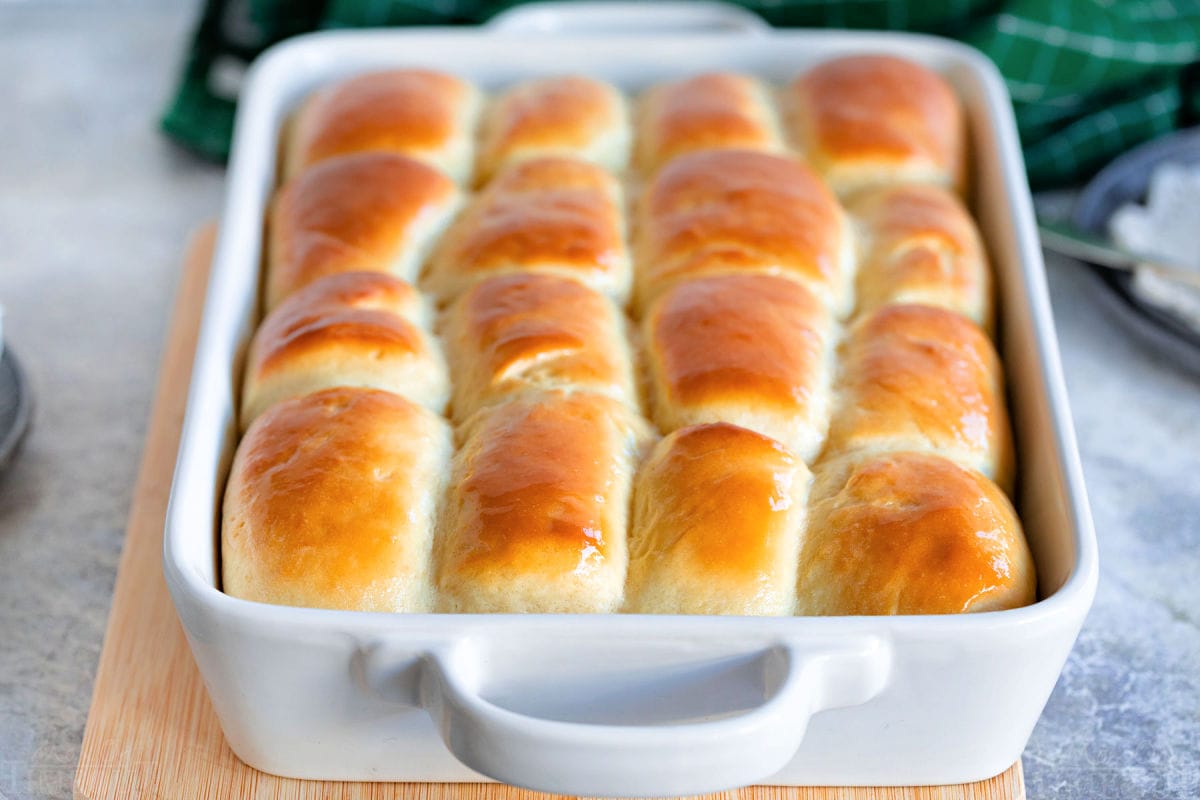
My Golden Rule of Bread and Roll Making
There are a lot of great tips for bread making but I would say the most important one is use the least amount of flour possible. You want the dough sticky and just barely manageable. Too much flour can lead to tough bread and rolls so really only add just as much flour as you need.
Storage Information
Store leftover rolls in an airtight container for up to 3 days. You can also freeze these rolls in a freezer safe container for 3 months. Thaw at room temperature, heat in the oven and serve.

Parker House Roll FAQs
These rolls were made famous by the Parker House Hotel in Boston when it opened in 1855. Rumor is their resident baker grew angry over something and threw a batch of folded, unfinished dough into the oven and out came these iconic rolls. The shape and method caught on and they’ve famously graced dinner tables and restaurants alike for over 200 years.
They sure can. You can bake them as directed, let them cool, then store the baked rolls in a freezer safe container for up to 3 months. Thaw at room temperature, heat in the oven and serve.
You can also freeze the dough. Go through the process all the way through the second rise. You’ll want to freeze them in the pan for about 8 hours, then store in a freezer safe container in between layers of wax paper for up to 3 months. Thaw the dough to room temperature and bake as directed above.
Yes! If you want to make the rolls the day before, make the rolls up until the second rise. Instead of letting the rolls rise again, cover and place in the refrigerator overnight or for up to 12 hours. Let rolls come to room temperarture and then bake as directed.
Trish’s Tips and Tricks
- When it comes to bread rolls you really want to add as little extra flour as possible. Even when handling the dough you want to very lightly flour your hands. You can also try greasing your hands instead.
- I suggest using softened butter as opposed to melted butter for easier handling. Melted butter can make a huge mess. Just make sure the butter is softened enough to easily be spread.
- Some recipes call for a sprinkling of sea salt over top just before serving. This is totally optional, they’re great either way!

More Biscuits and Rolls Recipes To Try
How To Make Parker House Rolls
Parker House Rolls
Ingredients
- 1 ¼ cup whole milk 110°F
- 3 teaspoons active dry yeast
- 6 tablespoons unsalted butter softened
- 4 tablespoons granulated sugar divided
- 1 ½ teaspoons fine sea salt
- 1 large egg plus 1 egg yolk room temperature
- 3 ½ to 4 ¼ cups all purpose flour
- 5 tablespoons unsalted butter softened, for brushing on dough, divided
Instructions
- Combine yeast, 2 tablespoons granulated sugar and warm milk in a large mixing bowl or the bowl of a stand mixer. Gently whisk together to combine. Let sit until foamy, about 5 minutes.
- Add 2 ½ cups of flour, salt, butter, remaining 2 tablespoons of sugar, egg and egg yolk. Attach the paddle attachment and turn the mixer to the lowest speed and mix until ingredients are incorporated, scraping down the sides of the bowl as necessary. Increase the speed to medium low and continue to mix for 2 minutes.
- Change the attachment to the dough hook, add ½ cup flour and incorporate the flour at the lowest speed, increasing to medium low when the flour is mostly incorporated, mixing for a total of 2 minutes.
- And another ½ cup flour and repeat, mixing at medium speed for another 2 minutes until a ball of dough is formed. Add additional flour as necessary, a couple tablespoons at a time.The dough should be sticky and soft and pulling away from the edge of the bowl but still sticking to the bottom of the bowl. The rule of thumb with bread and rolls is to add the LEAST amount of flour possible and still be able to handle the dough. Flour your hands or lightly grease if necessary.
- Transfer the dough to a lightly greased bowl (I simply sprayed with nonstick cooking spray) and cover with a towel or plastic wrap. Let rise at room temperature in a draft free space until doubled in size, about 45 to 90 minutes.
- Remove the towel or plastic wrap and punch the dough down gently.
- Divide your dough in half and transfer to a very lightly floured surface.We want to add very minimal flour to the rolls.
- Roll or pat out the dough into a rectangle measuring approximately 8” x 12” (a piece of printer paper is 81/2 x 11 so I use that as a guide.).
- Brush the dough all over with 2 tablespoons of the softened butter, a light coating, much like you would do for cinnamon rolls. I like to use softened instead of melted butter so it makes less of a mess. If you have a hard time brushing on your butter, it’s likely not quite soft enough so put it in the microwave for a couple of seconds until it’s so soft it’s almost melting.
- Cut the dough in half lengthwise so you have two 4″ x 12″ rectangles. Fold one rectangle lengthwise so it almost meets the other edge but not quite. You want about 1/2″ of the other edge showing. The rectangle should now be roughly 2 1/4″ x 12″. Repeat with the other rectangle.
- Cut each of the rectangles in half and then in half again so you have (4) 3″ pieces, Repeat for the other rectangle (you’ll now have 8 rolls cut).
- Turn the rolls over and place the rolls with the folded side down in a lightly greased 9 x 13 inch baking dish, four in a row, with the longer sides matching the longer side of the baking dish. (Refer to video or post above if needed.)
- Repeat the entire process with the second half of the dough. You should have 16 rolls in all.
- Cover the baking dish with plastic wrap or a light towel and let the rolls rise until not quite doubled in size but nice and puffy, about 45 minutes to 1 hour. As you see the rolls getting close to ready, preheat the oven to 350°F.
- Remove the towel or plastic wrap and bake the rolls for 20 to 25 minutes, until they’re golden brown and feel set.
- Remove them from the oven, and brush with the remaining softened butter. Pull them apart to serve.








Liz says
I decided to change from my regular bun recipe and made these rolls. They’re absolutely delicious and much easier to make than my regular recipe. I think this is a new favourite!!
Trish - Mom On Timeout says
I’m so glad you love the recipe as much as we do! We had these for Thanksgiving and crescent rolls for Christmas – so good!
Dave Porter says
I made these Parker House Rolls for Thanksgiving. Absolutely delicious! I did pick up some Challenge butter as I wanted to follow ALL suggestions… I will definitely be making these again! And, thanks for the history lesson ◉‿◉
Trish - Mom On Timeout says
I’m so glad you enjoyed the rolls Dave!